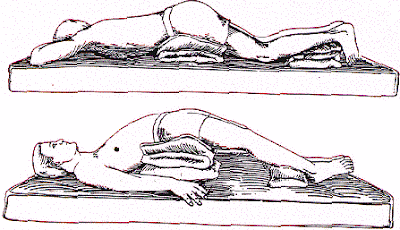To drain the middle and lower portions of your lungs.

You should be positioned with your chest above your head. Possible techniques to achieve this position are:
- If a hospital bed is available, put in Trendelenburg position (head lower than feet)
- Place 3-5 wood blocks, which are 2 inches by 4 inches, in a stack that is 5 inches high, under the foot of a regular bed. Blocks should have indentations or a 1 inch rim on top so that the bed does not slip
- Stack 18-20 inches of pillow under hips.
- Place on a tilt table, with head lower than feet.
- Lower head and chest over the side of the bed.
To drain the upper portions of your lungs.

You should be in a sitting position at about a 45 degree angle.
When you are in the proper postural drainage position, change your position per the following sequence:
- Turn side to side
- Lay on stomach
- Lay on back
Remain in each position approximately five to ten minutes. Use suction or assisted cough before changing position to insure removal of any secretions drained while in that position. Postural draining is usually taught by your physical therapist.
Inspiratory Muscle Trainer is a device to assist in building inspiratory muscle strength. The device should be used daily as part of your daily routine to keep lungs healthy.













